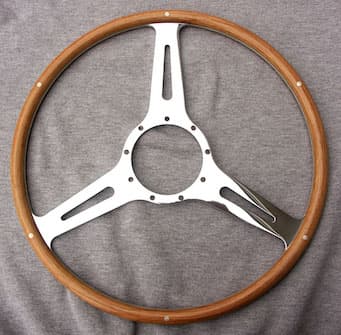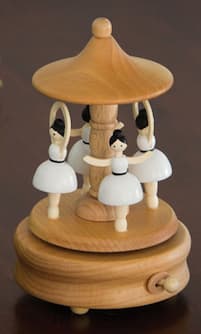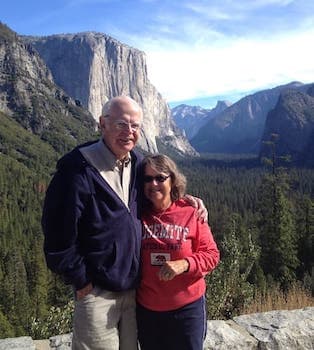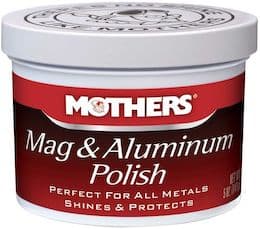
-----
Buffing lines appear when polishing aluminum
Q. I need help with getting the buffing lines out of aluminum from the buffing wheel. I tried Mothers Mag & Aluminum Polish after buffing but the rag still leaves marks. I get a good shine at one angle but you look at it at another angle and you see the lines. The piece I am doing is 1/8 in tail wing for a dirt track race car.
PLEASE HELP,
William Cramer- Bellevue, Ohio, U.S.A.
2003
A. William, you will probably have to treat this the same as a good coat of paint. Very fine sanding, buffing compound, polishing compound, fine scratch remover, and wax. If you go from a coarse compound to a very fine, with nothing between, the fine will not take out all the scratches from the course compound.
Good luck,
Ed Kay- St.Louis, Missouri
2003
A. Hi. First you must finish the piece by polishing at right angles to eliminate as many scratches as possible. Finish compound should be a rouge with the least amount of cut abrasive in the compound. The wheel must be straight cotton, either spiral sewn or multilayered muslin. Your speed needs to be right, along with the amount of compound on the wheel. To take off the last of the buffing lines, take either a fresh wheel or rake your wheel to remove all compound. Oscillate the part while polishing and finish with a back stroke to pull off the compound. A little known trick of the trade on aluminum is to add ivory soap to the compound which gives a beautiful deep color as well as cleaning streaks. Hope this helps.
Robin Thede- Toronto, Ontario, Canada
2005
Q. Dishwashing liquid? How do you add this ? This is a new one I've never heard of.
Bernard Gaitespolishing - langley BC Canada
March 21, 2016
Q. Aluminum dishware polishing. Hi: I recently obtained aluminum restaurant eating plates. They are very tarnished and I would like to at least get them back to the original aluminum luster. Is this possible at home and how is it done? Thanks.
Robert CampHobbyist - Austin, Texas
2005
A. Clean surface is important, flat surfaces are the Hardest (show lines easy if not done properly).
Would like to know what you have to work with (machinery, compounds, wheels or grinder). And what you are working on that you get lines. Possibly more prep, higher RPM tools, or compound.
Have 15 years in this occupation.
Thank you Patrick.
- Warren Illinois
November 14, 2011
Q. I've been custom polishing for over 5 years with awesome results but recently when polishing any fuel tanks I have to polish long and hard to get the mirror shine I'm used to getting (these are on logging trucks in really bad condition). Tanks and rims are extremely pitted from rocks. On bad condition aluminum I use an orbital palm sander with 320, 400 and 600 grit sandpaper. Tanks are very smooth and look like they're in perfect polishing condition ... but once I start, it's like a black film emerges. I think it's from sanding too coarse. If I only use 600 grit on the top of the tanks, I get an incredible shine. Normally it take 1 to 1.5 hours per tank but recently it's more like 3 or 4. Feel like I have to polish really long before it gets through this "layer" then comes an amazing shine. What can I do to reduce my time? To not have this dark layer appear? Any advice is very welcome!
Marten BraunPolishing - Clairmont Alberta Canada
April 25, 2020
Q. Polishing 6061 T6 aluminum.
I've been doing this work for a long time and still not satisfied with my process. I need to polish aluminum, flat discs of approximately 16" They are for steering wheels and have cut-outs for spoke designs. My current process involves several grades of sanding, then buffing. I would like to improve this process by lessening the time required to condition the metal for buffing and if possible, eliminate the buffing stage (big Baldor) as well.

I have a lapping machine and am about to experiment with different grades of diamond laps, hopefully progressing to a final polishing with a felt pad lap. I have purchased 320, 600, 1200, and 3000 grit diamond plates.
I'm not sure how to identify the degree of brightness but know that it is not a true mirror that I want. For this product, a true mirror would cheapen the look. I would like to be able to smooth the surface from the sheet stock finish and remove all scratches from the surfacing. I envision using an aluminum polish such as Mothers for the felt pad buffing stage.
My objective is to make the conditioning process more consistent in results, lessen the time investment, and improve the final result. Any and all advice is appreciated.
- Mount Pleasant South Carolina
May 21, 2021
A. Hi Michael. We have dozens of threads about polishing aluminum in this forum if you search the site. The easiest time-saving way to do at least the initial polishing is probably with some sort of mass finishing. Tumbling doesn't sound applicable to 16" diameter disks, but vibratory finishing might work, and if the volume is high enough to justify big equipment, drag finishing sounds ideal ...

(courtesy of bitsandpieces.com)
If you picture the pirouetting ballerinas on a merry-go-round music box, for drag finishing your disks would be fixtured to similarly spin on their centers while being dragged in a circular circuit around a 6' to 10' diameter bowl full of media ⇨
I could be in error, but I don't think the way you get where you want to be is by stopping short of mirror polishing. Rather, I think you first get to scratch-free & polished, and then go on to some sort of bead blasting or vibratory finishing with a selected finishing media.
Luck & Regards,

Ted Mooney, P.E. RET
Striving to live Aloha
finishing.com - Pine Beach, New Jersey
Ted is available for instant help
or longer-term assistance.
A. You say you do not want a true mirror, but that's what your photo looks like.
That's a nice polishing/buffing job, but I'd be concerned that it will degrade in service. To maintain the original luster. you'll need to have it anodized before the rim is installed.
Anodizing will somewhat dull the finish - work with an anodizer to get the look you want, and you'll also get a final finish that will last.

Jeffrey Holmes, CEF
Spartanburg, South Carolina
![]() Thank you, Ted and Jeffrey.
Thank you, Ted and Jeffrey.
The finish may very well be mirror. I'm not sure how to describe it other than say it is not a true mirror like what we look into in the morning. I once had a customer send me a wheel buffed to a true mirror and it was not period-appropriate or correct. It had cost him $500 for that job and I'm sure the provider was very proud of it.
My job is to make accurate reproductions of steering wheels from the late '40s through very early '70s. And I'm not interested in preserving the polish since the original wheels almost never had coatings. An anodized treatment would ruin the appearance.
I now have five diamond discs that I am just starting to mount so I can trial them as surface conditioners. The finest grain is 3000. I'm hoping that after conditioning, I can either use a felt pad and aluminum polish on the lapping machine or make quick work of it with the big Baldor.
- Mount Pleasant, South Carolina
A. I'm not sure what you mean by "anodizing will ruin the finish".
Anodizing can be done so it is invisible - no change in gloss or reflectivity; that depends on which alloy and the skill/willingness of the anodizer.
One of my first jobs was anodizing large reflectors for stadium lights. It was possible to have the anodizing be invisible, yet provide protection from atmospheric oxidation and weathering.

Jeffrey Holmes, CEF
Spartanburg, South Carolina
June 4, 2021
A. It's probably not helpful to your particular situation, but because this is a public forum with many more readers than posters, I must second Jeffrey's observation that very thin proper anodizing won't be visible and shouldn't hurt anything,
Luck & Regards,

Ted Mooney, P.E. RET
Striving to live Aloha
finishing.com - Pine Beach, New Jersey
Ted is available for instant help
or longer-term assistance.
Q, A, or Comment on THIS thread -or- Start a NEW Thread
